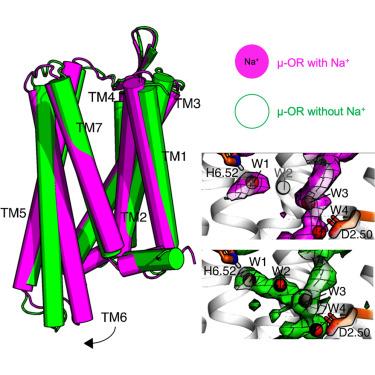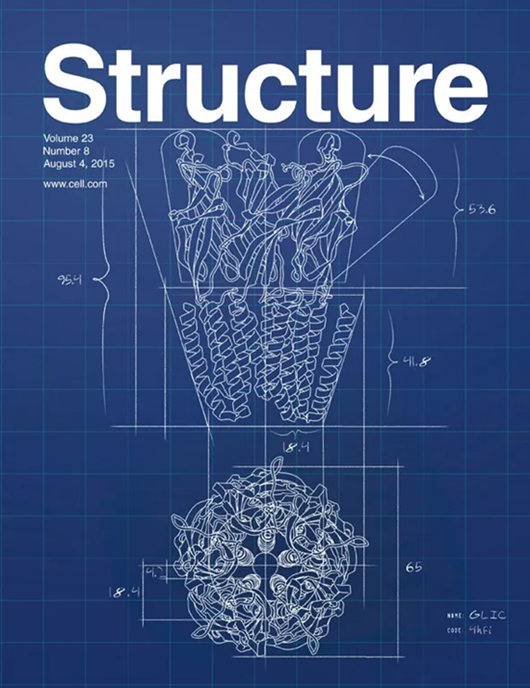钠离子调节负μ-阿片受体的机制
IF 4.4
2区 生物学
Q2 BIOCHEMISTRY & MOLECULAR BIOLOGY
引用次数: 0
摘要
20 世纪 70 年代,Na+ 离子对 G 蛋白偶联受体(GPCR)的负异位调节作用首次在阿片受体(ORs)中被描述,随后在大多数 A 类 GPCR 中也被检测到。在非活动状态 A 类 GPCR 的高分辨率结构中,Na+ 离子与残基 D2.50 附近的保守口袋结合,而活动状态的 GPCR 结构与 Na+ 结合不相容。相应地,Na+会降低激动剂的亲和力,使受体稳定在非活性状态,并减少基础信号传导。我们对μ-阿片受体(μ-OR)的μs-时间尺度生物分子模拟进行了基于相互信息的分析。我们的研究结果表明,Na+的结合与连接Na+结合位点和激动剂结合口袋的水丝以及极性网络的重排有关,而极性网络又将构象变化传播到激动剂和G蛋白结合位点。这些发现为离子的存在、激动剂亲和力的改变、受体失活和基础信号水平的降低之间提供了新的机理联系。本文章由计算机程序翻译,如有差异,请以英文原文为准。

Mechanism of negative μ-opioid receptor modulation by sodium ions
Negative allosteric modulation of G-protein coupled receptors (GPCRs) by Na+ ions was first described in the 1970s for opioid receptors (ORs) and has subsequently been detected for most class A GPCRs. In high-resolution structures of inactive-state class A GPCRs, a Na+ ion binds to a conserved pocket near residue D2.50, whereas active-state structures of GPCRs are incompatible with Na+ binding. Correspondingly, Na+ diminishes agonist affinity, stabilizes the receptors in the inactive state, and reduces basal signaling. We applied a mutual-information based analysis to μs-timescale biomolecular simulations of the μ-opioid receptor (μ-OR). Our results reveal that Na+ binding is coupled to a water wire linking the Na+ binding site with the agonist binding pocket and to rearrangements in polar networks propagating conformational changes to the agonist and G-protein binding sites. These findings provide a new mechanistic link between the presence of the ion, altered agonist affinity, receptor deactivation, and lowered basal signaling levels.
求助全文
通过发布文献求助,成功后即可免费获取论文全文。
去求助
来源期刊

Structure
生物-生化与分子生物学
CiteScore
8.90
自引率
1.80%
发文量
155
审稿时长
3-8 weeks
期刊介绍:
Structure aims to publish papers of exceptional interest in the field of structural biology. The journal strives to be essential reading for structural biologists, as well as biologists and biochemists that are interested in macromolecular structure and function. Structure strongly encourages the submission of manuscripts that present structural and molecular insights into biological function and mechanism. Other reports that address fundamental questions in structural biology, such as structure-based examinations of protein evolution, folding, and/or design, will also be considered. We will consider the application of any method, experimental or computational, at high or low resolution, to conduct structural investigations, as long as the method is appropriate for the biological, functional, and mechanistic question(s) being addressed. Likewise, reports describing single-molecule analysis of biological mechanisms are welcome.
In general, the editors encourage submission of experimental structural studies that are enriched by an analysis of structure-activity relationships and will not consider studies that solely report structural information unless the structure or analysis is of exceptional and broad interest. Studies reporting only homology models, de novo models, or molecular dynamics simulations are also discouraged unless the models are informed by or validated by novel experimental data; rationalization of a large body of existing experimental evidence and making testable predictions based on a model or simulation is often not considered sufficient.
 求助内容:
求助内容: 应助结果提醒方式:
应助结果提醒方式:


